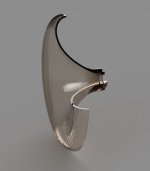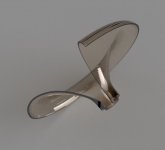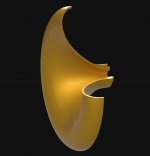A thought occurs to me: one could build, with only fair complexity, a single-purpose "lathe" that could grind out rotationally-symmetric objects from AAC (autoclaved aerated concrete). Or Corning Foamglas.Alternative -
Just need two axes of motion: one for a driven rotating shaft, and one for a sliding tool for material removal. The surface could then be finished with any number of fillers and top coats.
Last edited:
A thought occurs to me: one could build, with only fair complexity, a single-purpose "lathe" that could grind out rotationally-symmetric objects from AAC (autoclaved aerated concrete). Or Corning Foamglas.
Just need two axes of motion: one for a driven rotating shaft, and one for a sliding tool for material removal. The surface could then be finished with any number of fillers and top coats.
This can be done with a clever router jig. I've done it before for complicated (but axisymmetric) table legs. You'd need a pretty long ball mill to get down in there, though.
Poke around articles like this one, or this video for an idea of how it works.
I would think that making a mold (using these same techniques) and casting in plastic would be the better idea.
Molding (in resin, fiberglass, etc) would be my choice as well, but I can't deny that some of the endgrain waveguides posted earlier in this thread look gorgeous.
I would think that making a mold (using these same techniques) and casting in plastic would be the better idea.
What would you use specifically to cast with?
Having tried many different polymers, many of them get too hot, like epoxy (melted my mold!) unless the molds are metal (much more expensive to make.) What I found works best is glass bead filled (about 50%) 2-part polyurethane (there are many grades to choose from, see Innovative Polymers.) The mold can then be silicone or polyurethane, and then the molds themselves can be cast - from a prototype if available.
Having tried many different polymers, many of them get too hot, like epoxy (melted my mold!) unless the molds are metal (much more expensive to make.) What I found works best is glass bead filled (about 50%) 2-part polyurethane (there are many grades to choose from, see Innovative Polymers.) The mold can then be silicone or polyurethane, and then the molds themselves can be cast - from a prototype if available.
Would you use the TP or RC series?
One is hard and the other soft, don't remember which (I use both) but for casting you need the hard stuff, but not too hard and not too fast setting either. You need time to mix and pour.
Molds use the soft stuff and then you cast the harder material into the softer mold.
Molds use the soft stuff and then you cast the harder material into the softer mold.
On the topic of casting, has anyone here heard of epoxy granite? It's a composite (made of epoxy resin and various grades of granite or quartz aggregate) that's used extensively in the world of precision machining due to its vibration damping qualities.
There's also an entire subforum over on one of the DIY CNC sites exploring the concept. From what I've read it's possible to get great damping performance with supplies found at the local hardware store.
I've always wanted to try molding a speaker baffle with the stuff, and I'm beginning to think it would be a good opportunity to incorporate a custom waveguide.
There's also an entire subforum over on one of the DIY CNC sites exploring the concept. From what I've read it's possible to get great damping performance with supplies found at the local hardware store.
I've always wanted to try molding a speaker baffle with the stuff, and I'm beginning to think it would be a good opportunity to incorporate a custom waveguide.
Yes, someone actually recently posted photos here of a 3D-printed baffle with 90% fill (yikes). I suggested epoxy granite as a backfill material and they didn't respond. 🙁On the topic of casting, has anyone here heard of epoxy granite? It's a composite (made of epoxy resin and various grades of granite or quartz aggregate) that's used extensively in the world of precision machining due to its vibration damping qualities.
There's also an entire subforum over on one of the DIY CNC sites exploring the concept. From what I've read it's possible to get great damping performance with supplies found at the local hardware store.
I've always wanted to try molding a speaker baffle with the stuff, and I'm beginning to think it would be a good opportunity to incorporate a custom waveguide.
Is there a suitable filler for polyurethane that would allow easy further machining of the material (for mould making, not the final product)?
Last edited:
What kind of PU are we talking about? Castable foam?Is there a suitable filler for polyurethane that would allow easy further machining of the material (for mould making, not the final product)?
FOAM-iT!™ Series, Castable Rigid Urethane Foam | Smooth-On, Inc.
Molds should not be hard when casting poly. They should either be soft poly or silicone, neither of which is machinable. A hard mold can make removal of the part difficult to impossible,
My experience with expanding poly was not good. I do not recommend it. The glass filled poly is very machinable and extremely strong. I once took a sledgehammer to a bad cast waveguide to see what would happen ..... NOTHING! Not a crack or dent, nothing. No matter how hard I tried.
My experience with expanding poly was not good. I do not recommend it. The glass filled poly is very machinable and extremely strong. I once took a sledgehammer to a bad cast waveguide to see what would happen ..... NOTHING! Not a crack or dent, nothing. No matter how hard I tried.
Coax
Make this the paper cone of a coaxial driver? Sort of an updated version of the 15" Tannoy concentric?
Why would you make a separate waveguide if this can be made into a point source? The round-over can be incorporated into the baffle design so that the cone-to-baffle transition follows your model.
My concept is a combination of Genelec SAM baffle (8361A - Genelec.com) and Tannoy concentric, incorporating your advanced horn profile. Seems like a no brainer but I must be missing something.
referring to post #3842Alternative -
Make this the paper cone of a coaxial driver? Sort of an updated version of the 15" Tannoy concentric?
Why would you make a separate waveguide if this can be made into a point source? The round-over can be incorporated into the baffle design so that the cone-to-baffle transition follows your model.
My concept is a combination of Genelec SAM baffle (8361A - Genelec.com) and Tannoy concentric, incorporating your advanced horn profile. Seems like a no brainer but I must be missing something.
Last edited:
@ Mabat
Are you planning on filling these waveguides with 30ppi foam or are you doing without? Thanks.
Are you planning on filling these waveguides with 30ppi foam or are you doing without? Thanks.
The waveguide for HF1440, I'm gonna to try to cast this -
Were the sims of this wg posted previously?
What are the dimensions?
Last edited:
- Home
- Loudspeakers
- Multi-Way
- Acoustic Horn Design – The Easy Way (Ath4)



